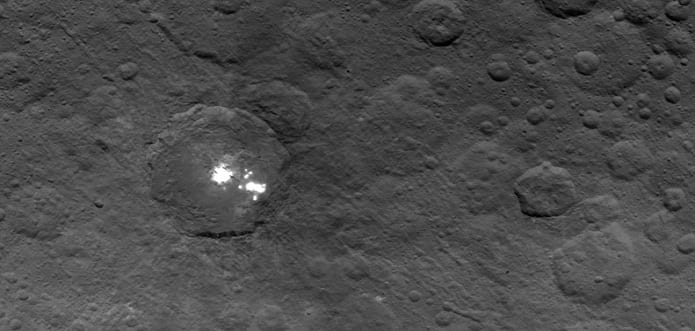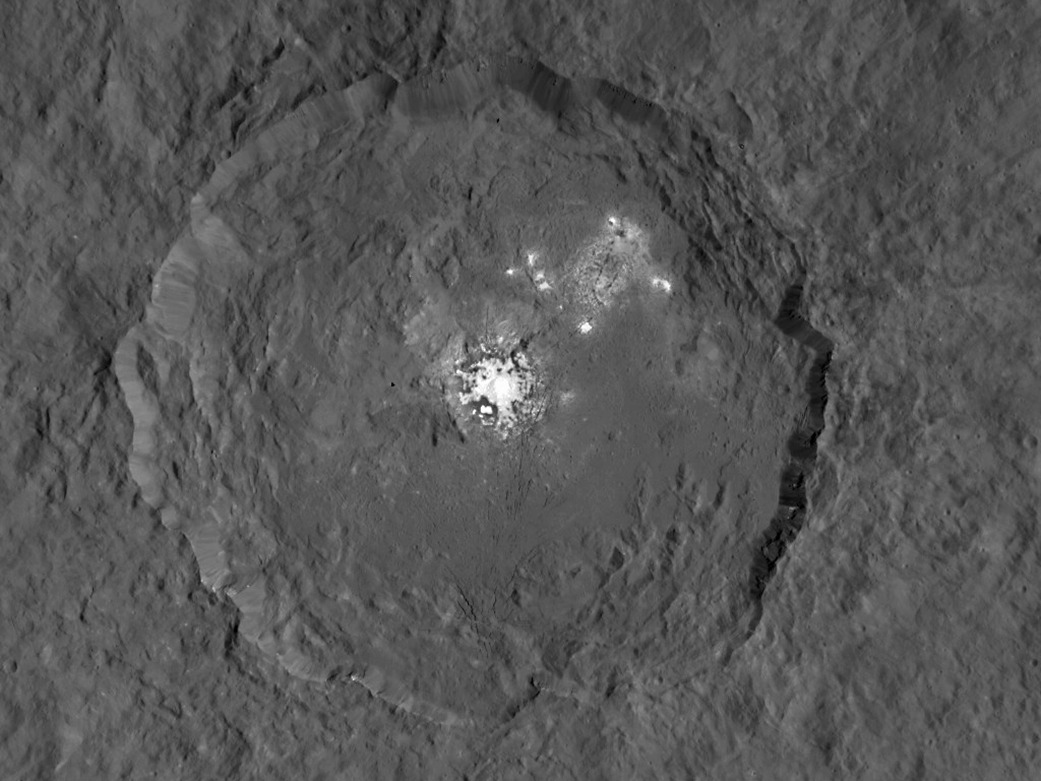Table Of Contents
NASA’s Dawn spacecraft takes close-ups of Ceres’s strange white spots but can’t explain them
NASA’s Dawn has taken close-ups of the strange and intriguing white patches seen in the middle of the huge Occator crater on the dwarf planet Ceres.
NASA’s Dawn started orbiting Ceres, an asteroid and a dwarf planet located between Mars and Jupiter, since March 2015 and it was also confirmed by the NASA officials that Dawn would continue orbiting Ceres through June 2016.
Dawn’s first orbiting revealed that Ceres showed more evidence of geological activity on its surface such as landslides.
The first footage from Dawn spacecraft also revealed some strange and intriguing white patches in the middle of a huge and dark crater.
Since then Dawn has completed its second orbiting with a closer look at Ceres and has provided with much more detailed view of the surface of Ceres. However, instead of solving the mystery the images are adding more confusion to these puzzled spots.
Ceres was one of the first asteroid to be discovered in 1801 and though it was originally considered as a dwarf planet it was reclassified as an asteroid in 1850 when researchers discovered many other objects in the asteroid belt lying between Mars and Jupiter.
Even after two centuries of its discovery, Ceres still remains a mystery to the scientists in terms of its origin and geology that is the major reason as to why NASA began their Dawn expedition in 2007. Dawn initially orbited Vesta from July 2011 till September 2012 and now it is orbiting Ceres.
You can take a closer look at the Occator crater on Ceres:
As per the map there is a four-mile tall ( 6 km) cone shaped mountain on the other side of the planet. Surprisingly, this mountain is pretty dark on one side and on the other it shows presence of bright streaks along the borders of the peak and to add to the confusion the land surrounding the structure is completely flat!
Paul Schenk, another Dawn scientist says: “This mountain is among the tallest features we’ve seen on Ceres to date. It’s unusual that it’s not associated with a crater. Why is it sitting in the middle of nowhere? We don’t know yet, but we may find out with closer observations.”
First the mysterious white patches and then these tall mountains, all these are really fascinating the researchers because they believe that unwinding these mysteries would lead them to understand the geological processes that would have led to the formation of Ceres and in a way it could also provide some important clues to understand our Solar System in a much better way.
Marc Rayman, the chief engineer and mission director of Dawn spacecraft said: “Dawn has transformed what was so recently a few bright dots into a complex and beautiful, gleaming landscape.”
He added: “Soon, the scientific analysis will reveal the geological and chemical nature of this mysterious and mesmerizing extraterrestrial scenery.”
Dawn will continue orbiting Ceres till June 2016, that means it would get closer to the dwarf planet indicating it would be providing us with much more detailed images in the recent future. In August, Dawn orbited Ceres at 915 mile high orbit and it takes around 19 hours for the spacecraft to complete one lap around the dwarf planet. In the month of October it would be moving in closer orbit and in these two months scientists would be capturing the images of the Ceres’ surface from multiple angles which they will use to build a 3D terrain map and stereo image catalog.
In its final orbit the spacecraft will move pretty close to the surface of Ceres which is about 233 miles (375 kilometers) from surface and scientists believe this would provide them with accurate measurement of the gravitational field and surface composition of the dwarf planet.
Well, hopefully the future footage would provide some clues to the scientists so as to unwind the mystery of these white bright spots and the pyramids instead of confusing and increasing curiosity!
Whatever it is, stay tuned to this page to get more news regarding the “Ceres World”.
Do take this tour of Weird Ceres along with its unique mysterious bright white spots and the tall pyramid shaped mountains.



